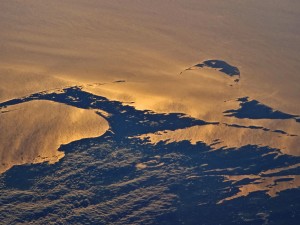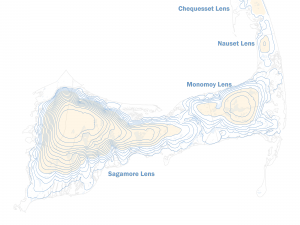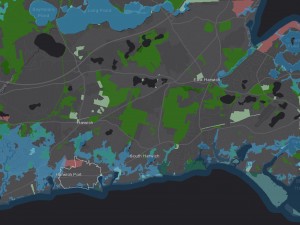Where does our drinking water come from?
The Cape Cod aquifer provides ALL of the Cape’s drinking water. Approximately 85% of Cape Cod is serviced by public water supplies, with the remaining 15% relying on private or privately-owned small volume wells to provide drinking water. The public water supplies on Cape Cod include eighteen separate water districts, municipal divisions, and departments; pumping from a total of 160 gravel-pack water supply wells and one surface reservoir. Private or small volume wells serve the Outer Cape communities of Truro and Wellfleet, and portions of East Sandwich.
Water Quantity
Since 2000, public community drinking water suppliers have pumped on average about 10.7 billion gallons of groundwater per year from Cape Cod’s Sole Source Aquifer. Except for Falmouth, which pumps approximately 50% of its drinking water from a surface reservoir, towns on Cape Cod rely entirely on the aquifer for their drinking water source. Annual pumping over the past decade has been fairly consistent with little variation from year to year. Study by the United States Geological Survey indicates that groundwater pumping accounts for approximately 10% of the annual recharge from precipitation.
Water Quality
Nitrate-nitrogen is a major component of human wastewater. Standard Title 5 septic systems remove very little nitrogen, and once introduced to groundwater there is minimal removal of nitrogen (in the form of nitrate) by natural processes. For this reason, nitrate is often used as an indicator of how development is impacting drinking water quality.
The Cape Cod Regional Policy Plan established a nitrogen loading concentration of 5 part per million (ppm) to ensure that nitrate levels in drinking water will not approach the regulatory standard of 10 ppm for drinking water supplies established by the United States Environmental Protection Agency and adopted by the Massachusetts Department of Environmental Protection.
The quality of Cape Cod’s community public drinking water supply is generally very good, but over the past 15 years there has been a trend toward some degradation. Nitrate levels in public supply wells have slowly increased over time due to increased loading from septic systems, stormwater, and other nitrogen sources.
Small-volume non-community drinking water wells, which are generally shallower, pump less water, and may be located closer to septic systems have been more susceptible to degradation than the larger and deeper community wells. In areas where wastewater disposal and private water supply often occur on the same lot, public water supply systems like those developed in Wellfleet and Eastham are a critical part of providing high quality drinking water to residents of Cape Cod.
Wellhead Protection
Over 30 years ago water planners combined their knowledge of groundwater with policy mechanisms to protect Cape Cod’s drinking water. Land areas where the precipitation contributes to recharge of the pumping wells were designated as Wellhead Protection Areas, which are protected today by town zoning and Board of Health bylaws. Current Wellhead Protection Areas can be viewed with the Regional Policy Plan (RPP) Data Viewer. The Wellhead Protection Areas are also referred to as DEP Zone IIs where Massachusetts Drinking Water Regulations (310 CMR 22) and the Regional Policy Plan apply more stringent regulations to limit land uses that are potentially detrimental to water quality.
Future water supply development
Following the establishment of wellhead protection areas, the public has embraced the acquisition of land for drinking water protection through local, regional, and state actions (e.g. the Cape Cod Land Bank). The Cape Cod Commission first identified remaining areas suitable for water supply development in 2001, and this catalog of Potential Public Water Supply Areas is periodically updated to remove lands that have been developed or impacted by nearby development. As a finite resource, the protection of lands suitable for future well development is just as critical as the protection of lands within the recharge area for existing wells.
To find out more, contact your public water supplier (last updated: 8/31/2023)
BARNSTABLE:
Hyannis Water Division, 508-778-6917 Water Quality Report (2022)
Barnstable Fire District, 508-362-6498 Water Quality Report (2024)
Centerville-Osterville-Marstons Mills Water Department, 508-428-6691 Water Quality Report (2024)
Cotuit Water Department, 508-428-2687 Water Quality Report (2024)
West Barnstable Fire District, 508-362-3241
BOURNE:
Bourne Water District, 508-563-2294 Water Quality Report (2024)
Buzzards Bay Water District, 508-759-4631 Water Quality Reports
North Sagamore, 508-888-1085 Water Quality Report (2024)
Otis Air National Guard Base Water, 508-968-4102 Water Quality Report (2022)
BREWSTER:
Brewster Water Department, 508-896-5454 Water Quality Report (2023)
CHATHAM:
Chatham Water Department, 508-593-4766 Water Quality Report (2024)
DENNIS:
Dennis Water District, 508-398-3351 Water Quality Report (2023)
EASTHAM:
Eastham Water Department, 508-240-5900 x3244 Water Quality Report (2024)
FALMOUTH:
Falmouth Water Department, 508-457-2543 Water Quality Report (2024)
HARWICH:
Harwich Water Department, 508-432-0304 Water Quality Report (2024)
MASHPEE:
Mashpee Water District, 508-477-6767 Water Quality Report (2025)
ORLEANS:
Orleans Water Department, 508-240-3700 Water Quality Reports
PROVINCETOWN:
Provincetown Water Department, 508-487-7064 Water Quality Report (2024)
SANDWICH:
Sandwich Water District, 508-888-2775 Water Quality Report (2024)
WELLFLEET:
Wellfleet Board of Water Commissioners, 508-349-0330 Water Quality Report (2023)
YARMOUTH:
Yarmouth Water Department, 508-771-7921 Water Quality Report (2024)
Contact
-
Tim Pasakarnistim.pasakarnis@capecodcommission.org




